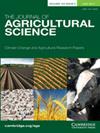Camel Herd Structure and Performance in Isiolo and Marsabit Counties, Kenya
IF 2.2
4区 农林科学
Q2 AGRICULTURE, MULTIDISCIPLINARY
引用次数: 0
Abstract
Urbanization and improved middle-level class income have caused an increase in demand for animal products and allowed economic growth in developing countries. Arid and semi-arid lands (ASALs), which support high livestock populations have an opportunity to contribute to the economy. However, their potential may not be realized fully due to the effects of climate change. This study aimed to establish camel herd structure and performance in Isiolo and Marsabit Counties, Kenya. Focus Group Discussions (FGDs) and a cross-sectional study were conducted from July to August 2022 in each County. Data on the herd size and composition (the number of age and sex categories) was collected from 388 households through structured questionnaires. The pregnancy test was done on seventeen camels four months after the mating season by tail cocking and progesterone assay method. Analysis was done using descriptive, correlations, and linear regression statistics at a 0.05 significance level. There were more female camels over 4 years in Isiolo (above 12%) than in Marsabit (below 10%). In Isiolo, milk yield was above 20 and 10 liters per day in wet and dry seasons respectively, while Marsabit production was below 10 liters in both seasons. Milk production coefficients were significant for the females above four years (p < 0.05). There were more households in Marsabit (63%) having a calving interval of 24 months and below than in Isiolo (50%). The tail cocking method did not correlate with the progesterone assay method in pregnancy diagnosis. The study concludes that, in Isiolo County, pastoralists are doing camel rearing with the objective of milk production unlike in Marsabit County. The recommendation is that pastoralists should be encouraged to adjust age and sex categories to increase milk production. Further, they need to apply an accurate cost-effective pregnancy testing method.肯尼亚伊西奥洛县和马萨比特县的驼群结构和表现
城市化和中产阶级收入的提高导致了对动物产品需求的增加,并推动了发展中国家的经济增长。干旱和半干旱地区(ASALs)养育着大量牲畜,有机会为经济做出贡献。然而,由于气候变化的影响,它们的潜力可能无法充分发挥。本研究旨在确定肯尼亚伊西奥洛县和马萨比特县的骆驼群结构和表现。2022 年 7 月至 8 月,在两个县分别开展了焦点小组讨论(FGD)和横断面研究。通过结构化问卷从 388 个家庭收集了有关牛群规模和组成(年龄和性别类别数量)的数据。在交配季节结束四个月后,对 17 头骆驼进行了妊娠测试,测试方法是翘尾和黄体酮检测法。在 0.05 的显著性水平下,使用描述性、相关性和线性回归统计进行了分析。伊西奥洛 4 年内的母骆驼数量(12% 以上)多于马萨比特(10% 以下)。伊西奥洛在雨季和旱季的日产奶量分别高于 20 升和 10 升,而马萨比特在这两个季节的日产奶量均低于 10 升。四岁以上女性的产奶量系数显著(P < 0.05)。产犊间隔在 24 个月及以下的马萨比特家庭(63%)多于伊西奥洛家庭(50%)。在妊娠诊断方面,翘尾法与黄体酮检测法没有相关性。研究得出的结论是,与马萨比特县不同,伊西奥洛县的牧民饲养骆驼的目的是为了产奶。建议应鼓励牧民调整骆驼的年龄和性别,以提高产奶量。此外,他们还需要采用成本效益高的准确妊娠检测方法。
本文章由计算机程序翻译,如有差异,请以英文原文为准。
求助全文
约1分钟内获得全文
求助全文
来源期刊

Journal of Agricultural Science
农林科学-农业综合
CiteScore
2.80
自引率
5.00%
发文量
68
审稿时长
1.4 months
期刊介绍:
The Journal of Agricultural Science publishes papers concerned with the advance of agriculture and the use of land resources throughout the world. It publishes original scientific work related to strategic and applied studies in all aspects of agricultural science and exploited species, as well as reviews of scientific topics of current agricultural relevance. Specific topics of interest include (but are not confined to): all aspects of crop and animal physiology, modelling of crop and animal systems, the scientific underpinning of agronomy and husbandry, animal welfare and behaviour, soil science, plant and animal product quality, plant and animal nutrition, engineering solutions, decision support systems, land use, environmental impacts of agriculture and forestry, impacts of climate change, rural biodiversity, experimental design and statistical analysis, and the application of new analytical and study methods (including genetic diversity and molecular biology approaches). The journal also publishes book reviews and letters. Occasional themed issues are published which have recently included centenary reviews, wheat papers and modelling animal systems.
 求助内容:
求助内容: 应助结果提醒方式:
应助结果提醒方式:


